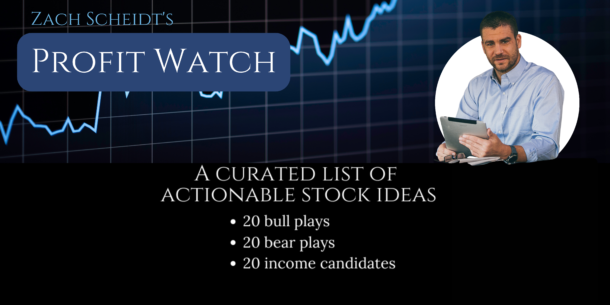
Every earnings season, hundreds of companies use a specific “accounting gimmick.”
It’s a transaction that when completed, will automatically increase earnings per share from what they would have been before.
The play has been used by executives in just about every industry. It’s a move that has drawn scrutiny from congress. And unfortunately most investors don’t understand how it works.
After today, that’s not going to be you! Because we’re about to dive into the world of “share buybacks.”
I’ll explain why executives love to announce these transactions.
We’ll explore how they affect the finances of different companies.
And once we’re finished, you’ll be able to go through this upcoming earnings season with a much better understanding of how these transactions affect your investments!
So let’s jump right in…
Watch For The Buyback Accounting Gimmick
Earnings season is set to kick off in earnest next week. Here are a few of the most important companies we’ll hear from.
Executives will be reporting profits for the third quarter, giving projections for how the year will end, and updating forecasts for 2022.
Wall Street’s army of analysts will be crunching the numbers and issuing buy or sell recommendations.
And investors like you and me will be digesting as much of the information as possible, and making decisions about where to put our capital into year end.
One of the things you’ll probably hear a lot about this earnings season is “share buybacks.”
While this is a completely legal (and sometimes productive) use of capital, some still consider this practice to be an accounting gimmick.
Here’s what happens.
Companies book profits, and then use those profits to buy shares of stock in the open market.
The company then retires the shares which means they are no longer in float.
Now there are fewer shares available for investors to buy. And each remaining share now represents a larger portion of the overall company!
Think about how this changes a company’s earnings per share…
Now, the company divides every dollar of profit by fewer shares. So each share claims a bigger portion of the profits. And if the company pays a quarterly dividend, the cash available for these payments will also be allocated among fewer shares.
Let’s take a look at an example.
Here’s How a Share Buyback Affects EPS
To understand how this “accounting gimmick” works, let’s think about a company that started the quarter with 1,000 shares.
Our company earned $1,000 in profit during the last quarter. So that gives us $1.00 per share in profits.
But what if our company had instead bought shares back with some of its extra cash?
Assume the cash was available and wasn’t needed for operations. So spending the cash to buy shares didn’t affect the company’s profits.
So we can divide the $1,000 profit by 900 shares. This gives us earnings per share of $1.11.
So by using this “accounting gimmick,” our company automatically increased profits (per share) by 11%. Impressive!
But is this a good thing or a bad thing for investors?
Like many things in markets, it depends.
And if you’re going to make good decisions about which stocks to invest in — and which ones to dump when they announce share buybacks — it’s important to understand the benefits and drawbacks.
The Good Side of Share Buybacks
Executives who decide to buy back shares often claim to be “returning capital” to investors. That might seem like an exaggeration because you’re not actually receiving any extra cash in your brokerage account.
But as you can see, in the example above, share buybacks do increase profit per share. So if you continue to hold the same number of shares, your portion of the company’s profits will increase.
Theoretically, if the shares continued to trade at a specific multiple of the company’s earnings — like 15 times earnings per share — a share buyback would actually increase the price of your shares.
In the example above, our shares started with $1.00 of profit each. And if the market priced these shares close to 15 times earnings, the stock price would trade near $15.
After the share buyback, the company earned $1.11 per share in profit. So if the market continued to value the shares at 15 times earnings, the stock would increase to about $16.65.
As an investor, you may not receive cash in your account, but the value of your investment should increase.
Some investors prefer share buybacks instead of the company paying dividends. Remember, dividends are taxable. But if you’re holding shares that increase in value, you won’t have to pay taxes until you sell the position.
So when companies spend cash to buy back shares, there can be some real benefits to investors.
The Downside of Share Buybacks
Share buybacks aren’t always loved… Some even consider buybacks to be “accounting gimmicks” that cause more harm than good.
The first question I like to ask about these transactions is “where did the money come from?”
In today’s low interest rate environment, some companies borrow large amounts and then use that cash to buy back shares. Since interest costs are low, the benefit to investors currently seems to outweigh the cost.
But when interest rates increase, those costs could become a problem! Especially if the company has to refinance its debt during a more challenging economic period.
(Remember, interest rates matter — especially for high growth tech stocks.)
A second question you need to consider is “how much did the company pay for shares?”
If the company gets a great deal on its purchases, that’s great! It will be able to retire more shares for the amount of money spent.
But if the company pays top dollar for each share, that cash payment won’t retire as many shares.
And if the stock pulls back later, it’s frustrating because that cash was essentially wasted! (It added less value than if the company had kept the cash.)
Hindsight is 20/20. But it’s important to consider what the company paid for the shares — and whether that price was reasonable.
The final question is “what could the company have done with the cash instead.”
This is a tricky one!
Because when a company uses its cash to buy back shares of stock, it is implicitly signaling to the market that it has nothing better to do with the cash.
That’s fine for a mature “cash cow” corporation.
But it can be a disturbing signal for growth companies when management returns cash to investors.
The devil is in the details. So watch these transactions carefully!
